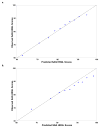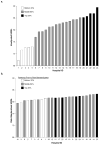Derivation and validation of a risk standardization model for benchmarking hospital performance for health-related quality of life outcomes after acute myocardial infarction
- PMID: 24163068
- PMCID: PMC4103693
- DOI: 10.1161/CIRCULATIONAHA.113.001773
Derivation and validation of a risk standardization model for benchmarking hospital performance for health-related quality of life outcomes after acute myocardial infarction
Abstract
Background: Before outcomes-based measures of quality can be used to compare and improve care, they must be risk-standardized to account for variations in patient characteristics. Despite the importance of health-related quality of life (HRQL) outcomes among patients with acute myocardial infarction (AMI), no risk-standardized models have been developed.
Methods and results: We assessed disease-specific HRQL using the Seattle Angina Questionnaire at baseline and 1 year later in 2693 unselected AMI patients from 24 hospitals enrolled in the Translational Research Investigating Underlying disparities in acute Myocardial infarction Patients' Health status (TRIUMPH) registry. Using 57 candidate sociodemographic, economic, and clinical variables present on admission, we developed a parsimonious, hierarchical linear regression model to predict HRQL. Eleven variables were independently associated with poor HRQL after AMI, including younger age, previous coronary artery bypass graft surgery, depressive symptoms, and financial difficulties (R(2)=20%). The model demonstrated excellent internal calibration and reasonable calibration in an independent sample of 1890 AMI patients in a separate registry, although the model slightly overpredicted HRQL scores in the higher deciles. Among the 24 TRIUMPH hospitals, 1-year unadjusted HRQL scores ranged from 67-89. After risk-standardization, HRQL score variability narrowed substantially (range=79-83), and the group of hospital performance (bottom 20%/middle 60%/top 20%) changed in 14 of the 24 hospitals (58% reclassification with risk-standardization).
Conclusions: In this predictive model for HRQL after AMI, we identified risk factors, including economic and psychological characteristics, associated with HRQL outcomes. Adjusting for these factors substantially altered the rankings of hospitals as compared with unadjusted comparisons. Using this model to compare risk-standardized HRQL outcomes across hospitals may identify processes of care that maximize this important patient-centered outcome.
Keywords: myocardial infarction; quality of life; risk factors.
Conflict of interest statement
Figures



References
-
- Krumholz HM, Normand SL, Spertus JA, Shahian DM, Bradley EH. Measuring performance for treating heart attacks and heart failure: The case for outcomes measurement. Health Aff (Millwood) 2007;26:75–85. - PubMed
-
- Krumholz HM, Anderson JL, Bachelder BL, Fesmire FM, Fihn SD, Foody JM, Ho PM, Kosiborod MN, Masoudi FA, Nallamothu BK. Acc/aha 2008 performance measures for adults with st-elevation and non-st-elevation myocardial infarction: A report of the american college of cardiology/american heart association task force on performance measures (writing committee to develop performance measures for st-elevation and non-st-elevation myocardial infarction): Developed in collaboration with the american academy of family physicians and the american college of emergency physicians: Endorsed by the american association of cardiovascular and pulmonary rehabilitation, society for cardiovascular angiography and interventions, and society of hospital medicine. Circulation. 2008;118:2596–2648. - PubMed
-
- Krumholz HM, Brindis RG, Brush JE, Cohen DJ, Epstein AJ, Furie K, Howard G, Peterson ED, Rathore SS, Smith SC, Jr, Spertus JA, Wang Y, Normand SL. Standards for statistical models used for public reporting of health outcomes: An american heart association scientific statement from the quality of care and outcomes research interdisciplinary writing group: Cosponsored by the council on epidemiology and prevention and the stroke council. Endorsed by the american college of cardiology foundation. Circulation. 2006;113:456–462. - PubMed
-
- Eagle KA, Lim MJ, Dabbous OH, Pieper KS, Goldberg RJ, Van de Werf F, Goodman SG, Granger CB, Steg PG, Gore JM, Budaj A, Avezum A, Flather MD, Fox KA. A validated prediction model for all forms of acute coronary syndrome: Estimating the risk of 6-month postdischarge death in an international registry. JAMA. 2004;291:2727–2733. - PubMed
-
- Boersma E, Pieper KS, Steyerberg EW, Wilcox RG, Chang WC, Lee KL, Akkerhuis KM, Harrington RA, Deckers JW, Armstrong PW, Lincoff AM, Califf RM, Topol EJ, Simoons ML. Predictors of outcome in patients with acute coronary syndromes without persistent st-segment elevation. Results from an international trial of 9461 patients. The pursuit investigators. Circulation. 2000;101:2557–2567. - PubMed
Publication types
MeSH terms
Grants and funding
LinkOut - more resources
Full Text Sources
Other Literature Sources
Medical

